How past determined present on precious metals
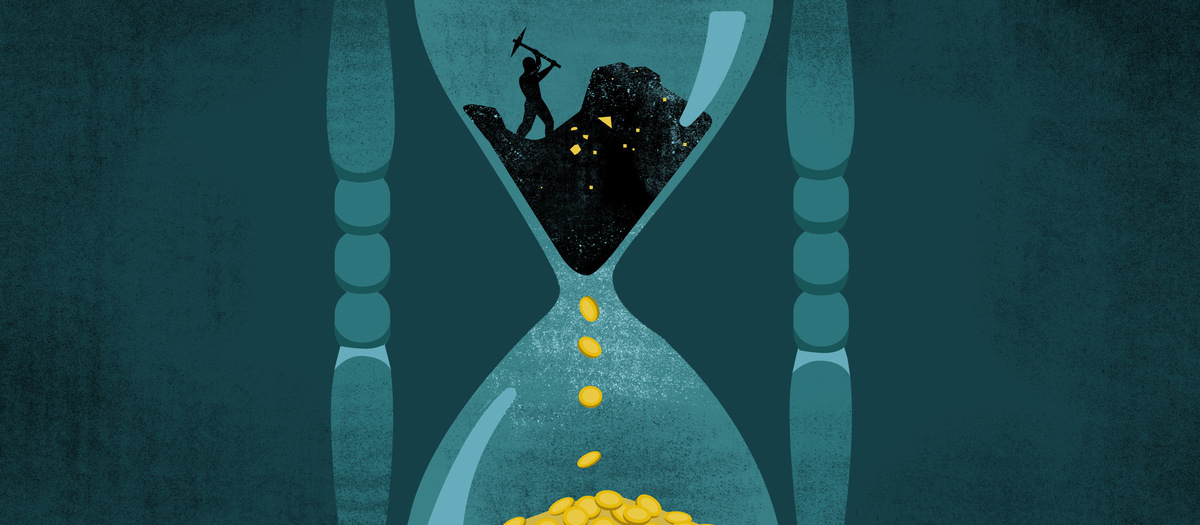
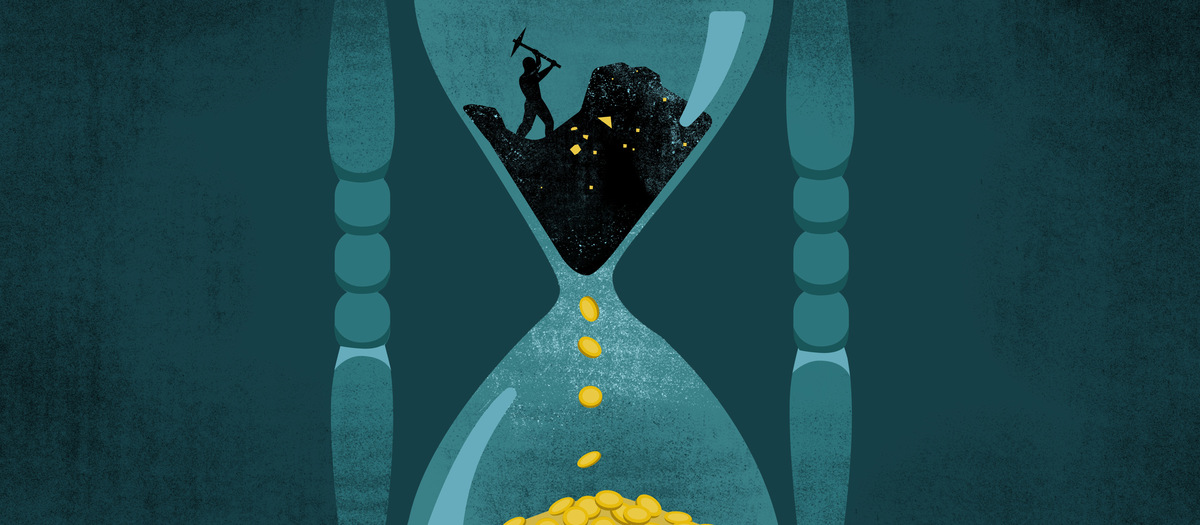
Gold and silver are metals known to humankind since millennia. They accompanied us as a metals symbolising ancient deities, then as a means of value, currency, eventually becoming special class of assets known as safe haven. It is interesting how their existence influenced humankind. And how the way we treated them in the past translates to modern standards.
Introduction
At Metal Market Europe, we are aware, that our analysis are data rich and market driven. But to be honest - numbers and digits, macro and trends - reading about that all the time, may simply become overwhelming and cause weariness or even boredom. We don’t want our kind readers just to slide over letters and numbers wondering ‘sigh, when it will end’. Just the opposite – we’d love to see you share our passion to precious metals - a class of assets cherished since eve of civilisation.
So to deliver above, today we present something completely different. We attempt to sneak something lighter in weight, tone, data, and less directly related to financial markets. And would our kind readers decide they like such subjects, we may continue providing such from time to time. Without neglecting current market developments of course.
After all, transition from bull market to proper bear is very interesting, as it is choppy, long, annoying, and turn many investors into capital donors. And of course is accompanied by fast-pace occurring Events. Written with proper capital ‘E’.
‘And do you know kind sires, how to recognise that time is historical? By the fact lot happens and fast.’
Above words were written by Andrzej Sapkowski, and appeared in ‘Narrenturm’ (eng. Tower of Fools), first book of ‘The Hussite Trilogy’, and set historically during 15th century Hussite Wars. And although above is historical fantasy, some truths – like the above - remain universal.
On recognition of gold and silver
Our ancestors initially as a hunter-gathering tribes populated most of the Earth by the time of Ice Age – 12k years ago. At a time our ancestors were nomads, travelling from place to place, feeding on what earth produced and what they managed to hunt. Abundance of natural resources and lack of enemies in form of wildlife predators and other tribes, was deterministic to length of stay on certain territory. Archaic humans knew how to cook on fire, procure primitive dress and commemorate great hunts by paintings on the cave walls. They also learned how to create first, very primitive shelters. They were also able to create first art, like Venus of Willendorf. They also knew how to produce some stone/wood made tools and weapons, hence the name – Stone Age (3.3 mln BC up to 3400-ish BC). But what really derived us from animals, was ability to take care of the others. Ability to patch the wound, fracturs and to provide protection during convalescence. That happened even before learning how to ignite fire or create tools.
Upon travels, wandering tribes were meeting other, and that often was deterministic to their future. Some had perished as their counterparts decided do not require others in proximity of their hunting grounds. Some were able to coexist for a time, and eventually absorb or become absorbed by others. Eventually they slowly progressed from hunter-gatherer towards more settled cultures. Human civilisation managed to domesticate cattle and sheep. Development of agricultural enabled to expand population, until then limited in size to food they were able (or not) hunt and gather. Creation of temporary and later permanent settlements enabled progress in pottery, ceramic, textile creation, improvement on tools and weapons. First astronomical and religious buildings had been erected. Settlers were no longer restricted in weight of belongings when travelling from place to place. Now, they could’ve create more advanced tools and even do art – which as a nomad hunter-gatherers haven’t had means or time to make. These were initially being made of stone, wood and bones.
Finally our ancestors realised on existence of metals. One of the theories says, that copper and gold were discovered by accident, when certain toolmaker was gathering stones to turn them onto tools. First metal tools were being made by making strokes on the metal. That didn’t result in particularly good quality of tool. But soon it was discovered metal could be melted when exposed to high temperatures, and then formed onto tool from liquid form. To do that, in time, they created first ovens, fuelled by charcoal and eventually with addition of first primitive blacksmith bellows to increase temperature. Eventually first metal smelting sites started to appear. Belovode in Serbia is considered oldest (5000 BC!) copper smelting site. From then, humankind experience transition from copper to bronze, then discovered alloys which led it to learn how to process iron.
So, humankind didn’t create civilisation yet, as per archaeological and historical definitions. However our ancestors discovered means and ways to mine shallow metal ores, grind them and further process to obtain tools and weapons. But that was gradual process requiring technological advancements. Copper melts at 1085 °C, bronze at 890 °C, silver at 961 °C, gold at 1064 °C. That makes bronze achievable as first. Upon learning how to do so, humankind started its thousands yearlong transition from Stone Age to Copper Age and then to Bronze Age (approx. 3400 BC – 1200 BC). At the time manufacturing iron tools and weapons was still for a while beyond technological skills, as its melting point is at 1538 °C. Transition to iron occurred around 1300 BC.
It is at Bronze Age (approx. 5000-3000 BC in Europe) when gold and silver did enter the stage. The eldest golden trinkets and jewellery ever discovered are being dated to 4600-4200 BC and were being found in burial sites near Warna in Bulgaria. That makes them older than Babylonian or Egyptian. Approx. 300 graves, 3000 items made of yellow metal.
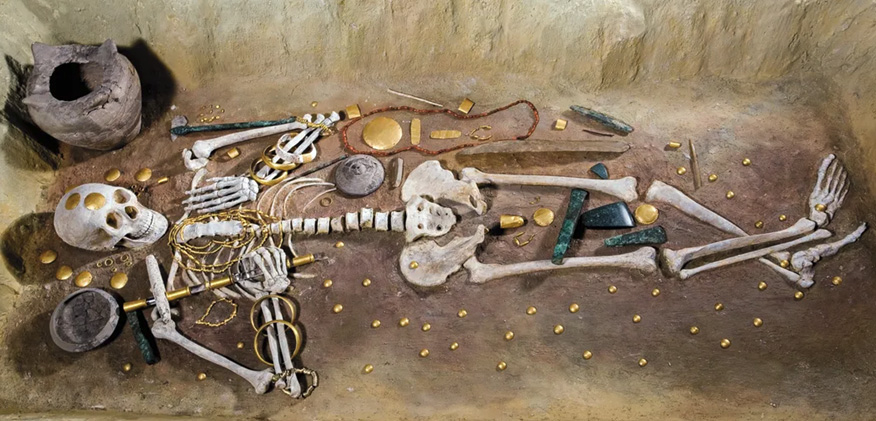
Final resting place of a tribe chief in Warna, recreated by archaeologists. Source: https://www.smithsonianmag.com/travel/varna-bulgaria-gold-graves-social-hierarchy-prehistoric-archaelogy-smithsonian-journeys-travel-quarterly-180958733/
Progress and need for security and to own goods led to emergence of civilisations, like Mesopotamia, Egypt, Greece and later Rome. It never was peaceful process, so metallurgical products were more than welcome. Civilisations learned how to use seven metals. Seven metals of antiquity we call them - gold, silver, copper, iron, tin, lead and mercury. Each had its unique properties discovered by variety of try-outs. Newly emerged civilisations although advanced in certain aspects like astrology were limited by technology. Hence believed in existence of seven celestial bodies they were able to observe: Sun, Moon, and five planets Venus, Mars, Mercury, Jupiter, Saturn which they thought all revolved round the Earth. This coincidence apparently suggested a relation between seven metals and seven celestial bodies. Additionally celestial bodies were associated with deities, as early civilisations believed in polytheistic pantheon, that allowed them to provide explanations about what is happening around them – solar eclipse (gods are angry), volcano eruption (gods are angry), poor crops (gods are angry) or plentiful crops (gods are pleased). With each celestial body associated to deity and with one of the metals, astrological symbols of these bodies became symbols of respective metals.
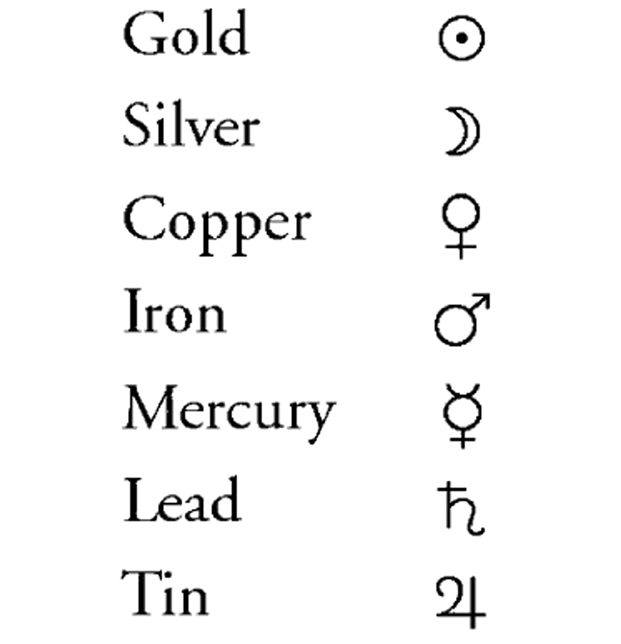
Symbols of celestial bodies associated with antiquity metals. Source: Fathi Habashi, The Seven metals of antiquity
Thus gold was denoted with the Sun’s symbol of a full circle which represents mathematical perfection. As Sun was dominant celestial body, gold had a similar ranking among metals. Gold was also associated with Sun by virtue of its bright yellow colour. And its scarcity, only proved its value. Silver, which ranked second in perfection was associated with the Moon. It has been marked by a half circle resembling the crescent Moon. Mars – bloody red planet – was quickly associated with local gods of war. What other metal could serve conquests and defence if not iron. Etc. etc. etc…
On need to create money
Past made trade was socio and psychologically interesting, as before inventing money counterparts had to use something else and establish individually product values between themselves.
It was typical within tribes, villages, then civilisations and nations to have more effective and skilled in certain aspects goods manufacturing units. Hunter provided furs and meat, shoemaker produced shoes, farmer grain and vegetables… Also there were regional specialisations. Seaside villages produced salt, by evaporating it from seawater. Certain villages in more specialised and territorially larger structures were responsible for providing just one type of goods, like meads, or precious metal ores. That is where first price mechanisms appeared, as some villages had abundance of i.e. grain, but were in lack of tools. It’s time to quote father of economics – Adam Smith:
‘Butcher has more meat than he can eat, and the brewery owner and baker would like to buy some of the meat from him. However, apart from their own products, namely beer and bread, they have nothing to offer the butcher. If butcher has previously acquired the beer and bread he needs, then the exchange between them will not take place.’
And so people tried barter, which is to exchange goods and pay with commodity money. How much grain for shoes? How many bear furs for iron tokens? Problem was majority of goods had expiry date, so hoarding them for future was impossible. And giving change in transaction was utter nightmare. Also prices differed vastly depending of geography, as logistics was time consuming, dangerous and costly. Egypt had basically one trading route – Nile. Greece was divided by mountains, so it was easier to pack goods on ships and travel by the coastline, then via land routes.
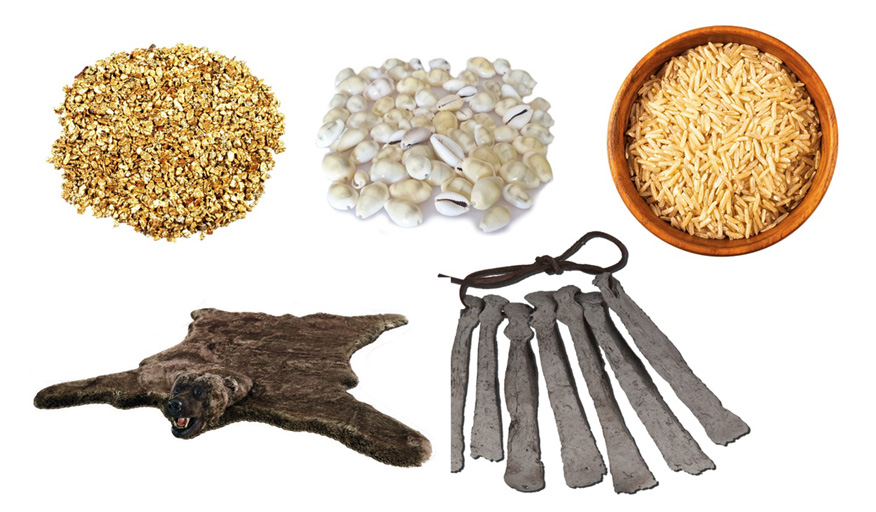
Various exemplary types of commodity money. Source: Our own compilation
Some societies arbitrary made a decision about using symbolical tokens of value, like seashells or rice. Problem was, such means might’ve been useless outside their sphere of influence. As according to economics, to exist and to be circulated and used in exchange for goods, money has to be:
- Acceptable by the state and its citizen.
- Recognizable and circulating.
- Relatively rare, which generates its value, which generates portability (ease of transporting a large value).
- Divisible, or multi-nominal. After all, change must be somehow expressed.
- Durable and immutable over time. Its physical quality has to be preserved in same condition today and in future.
- Has to store value over time.
Nowadays, even fiat money doesn’t meet all these requirements. But again, discussing theory and practicality is something totally different. But to meet trading needs and to store value, it was gold, silver and copper started to be used in the vast majority of cases. Actually copper is not a precious metal, but considering that gold was royal and noble money used for high value transactions, silver was predominantly used by merchants and profitable business owners, copper has been used predominantly in everyday transactions. So precious metals evolved from jewellery, religious items and means of storing value, towards something completely different – money. And that happened basically all around the world.
And divisibility issue has been resolved in two ways. Either by giving change in coins, or simply by cutting coin with sharp tool, so both counterparties be satisfied.
Coin as we know it
First coins date back to the 7th century BC and were found around the temples of Ephesus in Lydia. In shape they resembled larger beans with a primitively minted obverse. Initially, it was an individual mark of merchant, which served as a sign of quality and advert of said individual. In time obverse gradually evolved into a symbolic representation of a state or city. For long, reverse was concave, which was indication of early minting methods requiring an anvil, metal stamps with carved convex ‘logo’, hammer and repeatable physical strength. Small iron stamp used to strike ‘logotype’, was especially demanding for artist creating it. This is because coins were small in size, and technology not that advanced. Both factors were then deterministic to the amount of details. But with the development of minting technology, designs became clearer and engraving deeper. Over time, handicraft was replaced by special punches and mechanization, and today by modern casting technologies and laser cutting.
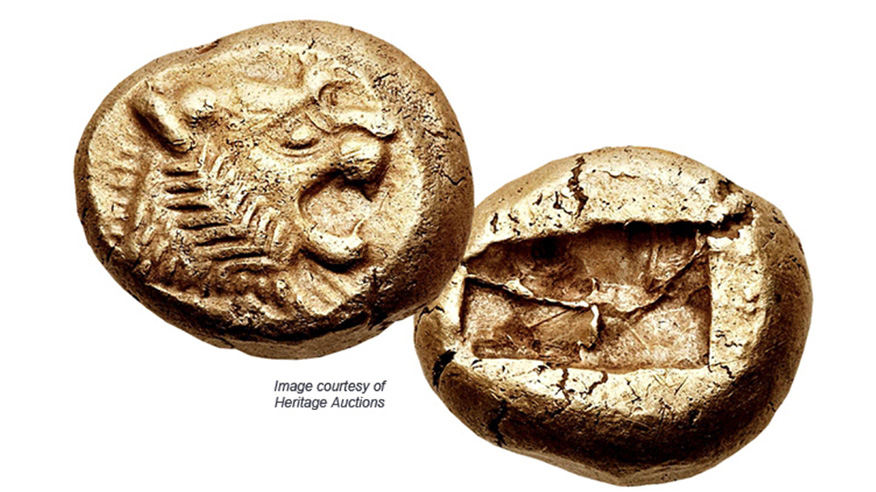
First type of coin. Made in Greek Lydia, Source: https://www.egypttoday.com/Article/4/113533/The-first-currency-in-history-Kingdom-of-Lydia-minted-gold
Around the 5th century BC, coins in Athens started reassemble near-circular shape. It was then that emblem on reverse was introduced. One side usually depicted city (Greek Polis) symbol, other presented regional guardian deity. But then, Alexander the Great signed himself to the annals of history, by conquering whole known world, and even reaching legendary lands of Indus. Who else could then be immortalised on a coin, if not him? And since Roman Empire this became standard, with emperor peeking on what we spend money for.
Of course adding profile of his / her majesty also served different then sole commemoration purposes. It served informational and advertising purposes. ‘Look how glorious and rich is our nation. What wars we had recently won, where we expanded recently our faith, and how recently re-drawn our borders. What buildings we erected and what achievements our scholars and inventors made – all under my guidance and patronage. We exist and do well enough to mint coins with my profile – so we have precious metals in abundance. I am the ruler of this prosperous country and dominant nation. And we could use specialist like you for the glory of our principality / kingdom / empire’. No wonder that foreign coins acquired as an effect of international trade were quickly minted to local standards, so now local ruler could shout out of your purse: ‘Look how glorious and rich is our nation…’
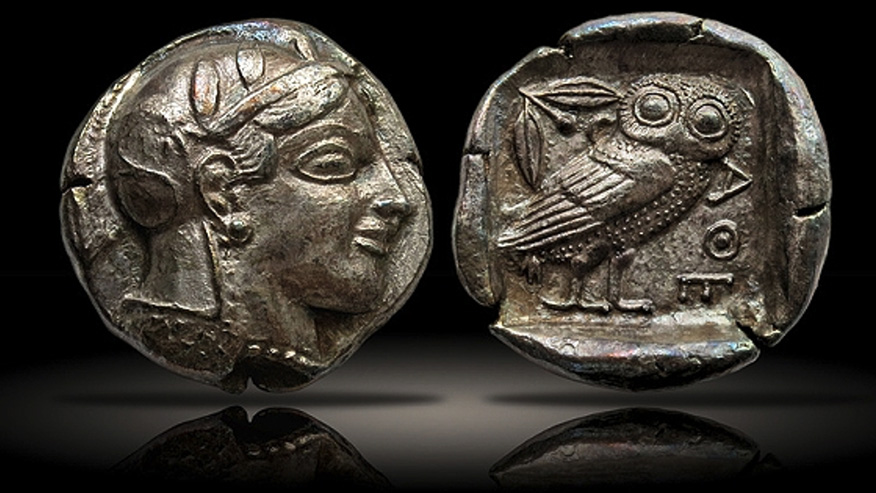
Athenian drachm. Goddess Athena on one side, and on the other Athenian symbolic animal – an owl. Source: https://coinweek.com/ancient-coins-famous-coin-antiquity/
Face value wasn’t needed yet, as coins made of precious metal had certain weight. Silver through ages oscillated in between 8 to 14 units exchangeable to one unit of gold. This started to change with the end of 19th century. Of course coins were not pure silver and gold, as achieving that was beyond technological skills of our ancestors. 96-98% purity was maximum. Addition of other metals – silver and copper to gold and copper to silver coins - made coins sturdier – more resistant to friction. Additions to gold coins also made them slightly bigger in size and less yellowy gold. Just compare today’s Krugerrand to i.e. Maple Leaf – same amount of gold, but additions to the first made it bit larger in size and darker in colour.
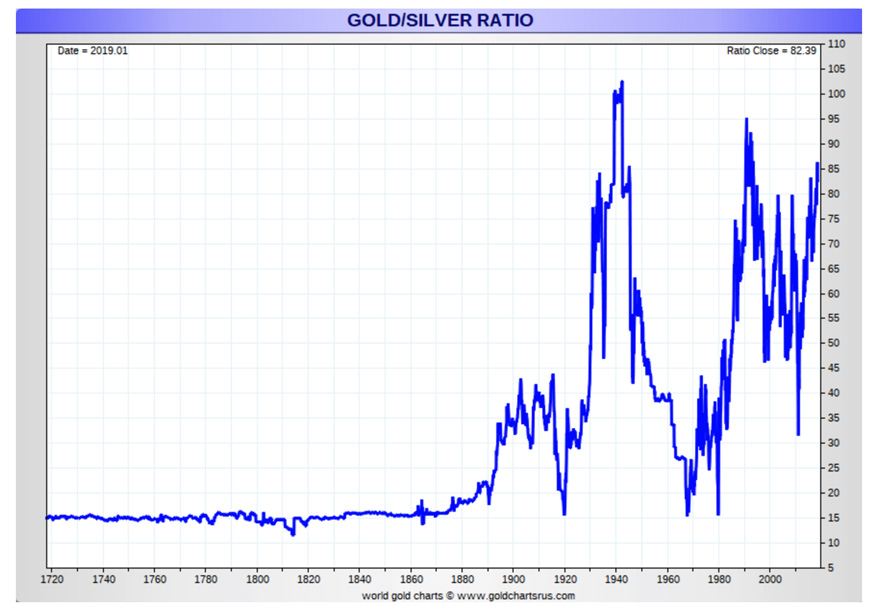
Gold - Silver ratio. Source: https://orchidsgrowingcare.com/82900_36_symbolic_sl/82915_slope_ratio_ch/
Minted face value – representation of value – was being introduced closer to our times, when amount of precious metal in coin had diminished. Hence i.e. 18th century coins had face value equalled to silver or copper or gold amount in the alloy. Maintaining balance between face and intrinsic value was uneasy task as required maintaining less price fluctuations on precious metals. Notable example of failure to do so, are early 60’s of 20th century in USA, which failed to maintain still price of silver, making value of silver content in 1 dollar coin to exceed nominal coin value.
Soon, great Greek invention of coin had been exported around the world. Persians and Romans were influenced by Greeks. Then Romans influenced all bordering tribes and nations. Rome Empire has been eventually divided to east and west. Western Rome had fallen, but its heritage remained somehow as an inspiration to soon-to-be established western kingdoms. But Byzantium remained on maps for the next millennium, and its monetary system continue to influence everyone around – Persians, Arabs and Europe itself. Based on byzantine experiences, Arab dinars and dirhams started to influence Europe. And eventually with the age of discovery and ascertaining its dominance, European money started to circulate around the world.
But there is one more element, which we owe to ancient Romans. That is side of the coin. Usually it is notched with dense grooves. This is a security feature developed initially by Romans, then forgotten for ages, and then again re-discovered over past few centuries. This is because in the old days, coins were imperfect in its round shape. So more ingenious users tend to file or clip off edges and acquire some extra precious metal.
Rise of the troy ounce
Everyone in the precious metals sector seems to be familiar with term ‘troy ounce’. That is standard unit of weight used for precious metals. That is 31.10 g. It differs from standard ounce used in Anglo-Saxon world, which equals 28.35 g. That complicates things a bit, especially if considering that most of the world operates with kilograms and tonnes. Contrary to that, majority of precious markets in the world use troy ounce as a basic unit and operate in its multiplications. Comex contract equals 100 troy ounces of gold. LBMA’s is 400 oz. Shanghai however decided otherwise, and approved kilogram as a basic delivery unit. Which was a bow towards non-US and non-UK customers.
But why troy ounce? Why not something more round in weight, and why 31.1 g?
Glad you’ve asked. Long time ago in 486 AD, Western Roman Empire had finally fallen under pressure of nations and tribes pushing from the east. Of course mass migration crisis was just a straw that broke the camel’s back, as Rome was in long-time decline of imperial authority, internal and external political instability, natural changes in climate, empty treasury, social crisis, army crisis, fall of traditions and overall ongoing degeneration. Its territories had been conquered and used for settlements by Goths, Germans, Visigoths, Vandals, Franks etc. – basically all the tribal confederacies either previously settled within its borders, nomadic or neighbouring. Of course they had their own customs, religions, social structures etc., however they lacked technological advancement of Romans, and especially they didn’t possess knowledge of writing, to preserve history. That’s the reason, today we consider them as brutal ravaging barbarians – as this is how ex-Roman and Byzantine historians described them.
The truth is however, tribes were able to create more complex structures and eventually created variety of states. Infamous Vandals i.e. established prosperous trading empire in North Africa. At least until being conquered by Byzantium. However in many aspects, new masters lacked technological experience and skills of their Roman predecessors. They tried to copy / paste, but with various results. So coinage at a time was simply a poor copy of Roman, both in quality, weight and size.
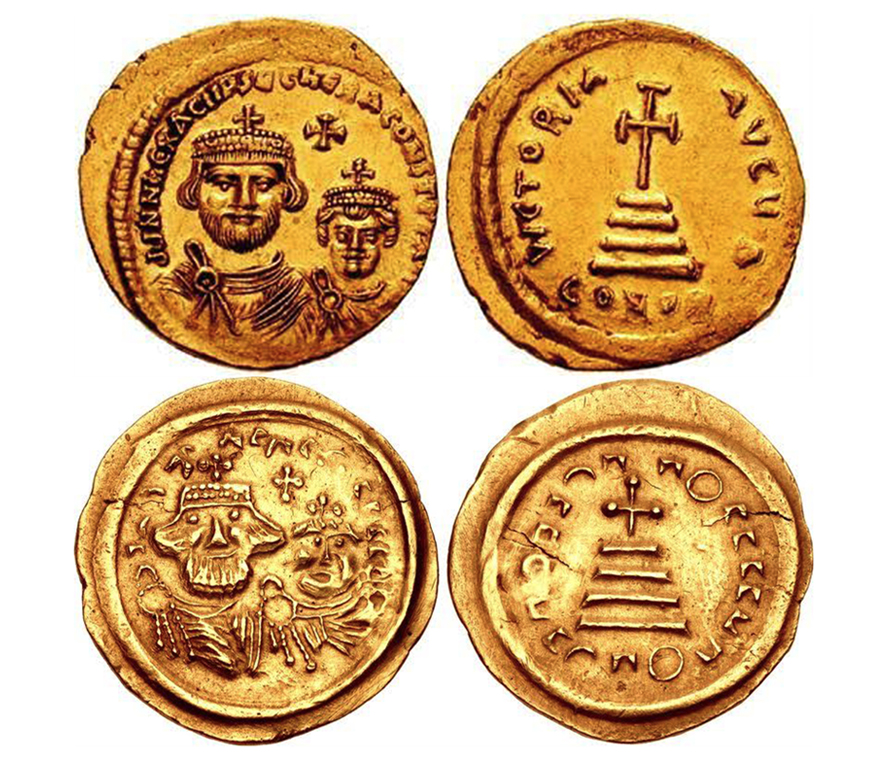
Byzantine gold solid from first half of 7th century and its copy made by Avars, inhabiting Pannonia at a time. Western Europe was capable, to produce even better “monstrosities” Source: Compilation based on https://en.numista.com
However solidification of state structures eventually enabled to improve farming, building, or coin mintage. But the main problem in newly formed entities lied in distances. Having an organised and well maintained empire allowed for some sort of unification, however strong decentralisation as in medieval, was more supportive to create different local standards, cultural but also in measurement and weight units. I.e. pound could’ve been in between 360-500 g. depending of a region, even in the same country. Of course considering that regions didn’t use different unit i.e. mark. Medieval merchant must’ve had a strong math skills then.
And is then, in 15th century, when French city of Troyes decided to re-do its local weight standards. One pound (approx. 374.4 g.) was composed of dozen of ounces (31.1 g.). One ounce was composed of 20 pennyweights (based on penny / denar system). One pennyweight was equal 24 grains 0.065 g.). So troy ounce equalled in weight 480 grains. Yes, that is correct. Weight of troy ounce was based on historical weight of penny / denar from the times of Charlemagne, which was based on multiplication of weight of a single grain. That is because, to establish prices or determine value of a merchandise, initially people were using what was the most common in the region. Could’ve been fish, iron bars, or fur. But with establishment of certain structures and civilizational progress, societies became predominantly agrarian, hence grain.
But how to explain differences between ounce and troy ounce. Standard ounce (28.35 g.) was being based on multiplication of heavier barley grains. However apothecaries, alchemists and jewellers needed something lighter, to determine weights as close to what they wanted achieve as possible. Hence, it was decided they will be using wheat grains, as four of them equalled three barley grains. And here appears English influence, as 15th century was time of the Hundred Years War. In 1420, Henry V has been recognised as regent and hair to the French throne, by the Treaty of Troyes. It is possible that then he made a decision to implement troy system to English soil, as it was much logical than tower pound. From there, troy ounce followed British fleet, colonists and soldiers. Upon further transition to banknotes, parity and then fractional reserve, troy ounce remained incorporated onto British monetary system in 1717 by Director of the Royal Mint in London Sir Isaac Newton. He established parity of British pound to gold at 7.32 g. This meant, troy ounce equalled 4.31 pounds. With just minor fluctuations and pause due to First World War, parity has been preserved up to 1931 (and for most of the time stood rather at 4.25 pound). So troy ounce has been preserved by and through the existence of vastest empire in the world. With all financials tied at a time and influenced by London. Even at former colonies, as in 1828 US Mint recognised troy ounce as a unit of weight.
Summary
We hope, kind readers enjoyed our slightly different analysis related to precious metals. Now, when someone in your presence will quote famous but out of context words of J. M. Keynes, stating - gold is barbaric metal – you’ll have sufficient information to explain him…
... that he’s right. And in similar way as all the other barbaric knowledge and achievements, it influenced and helped to build foundations of our civilisation, storing value in time and achieving prosperity.